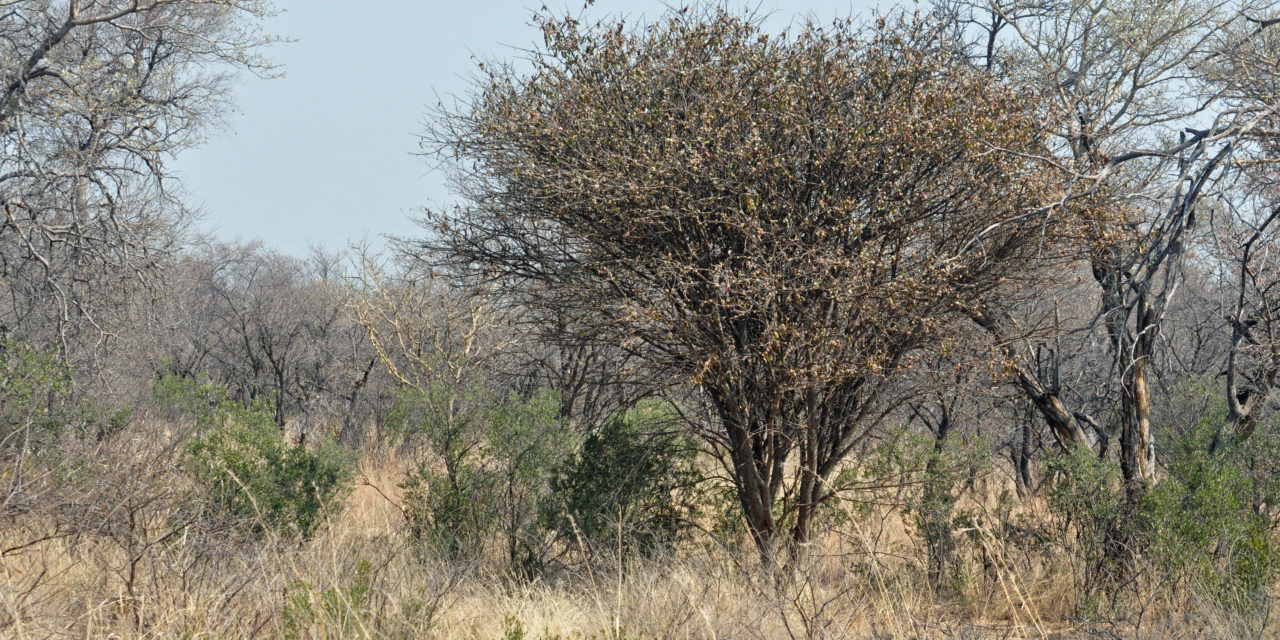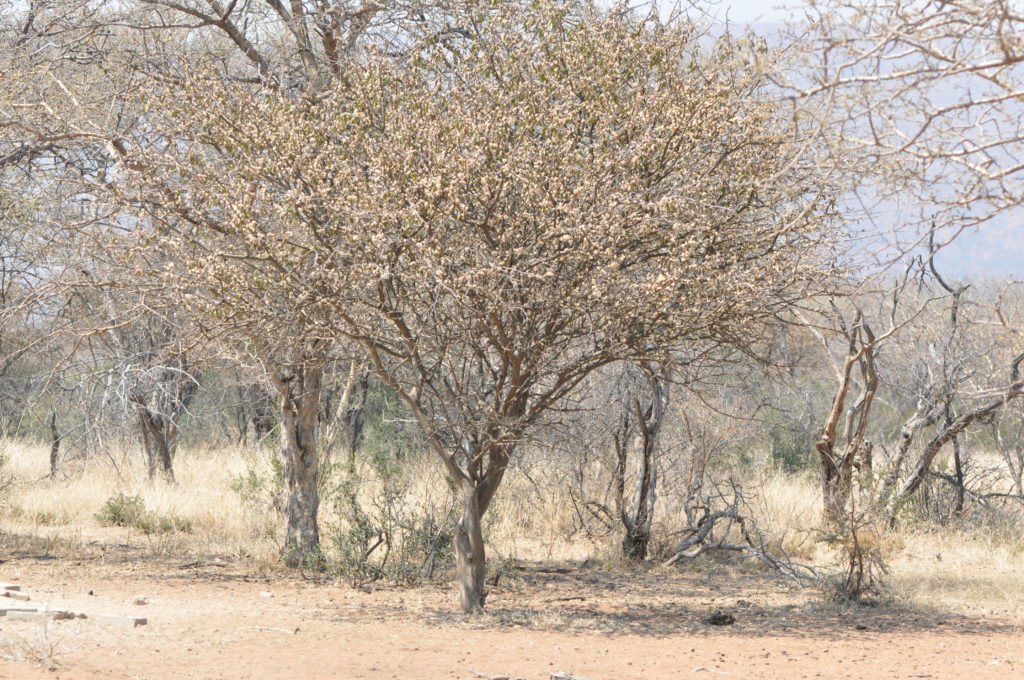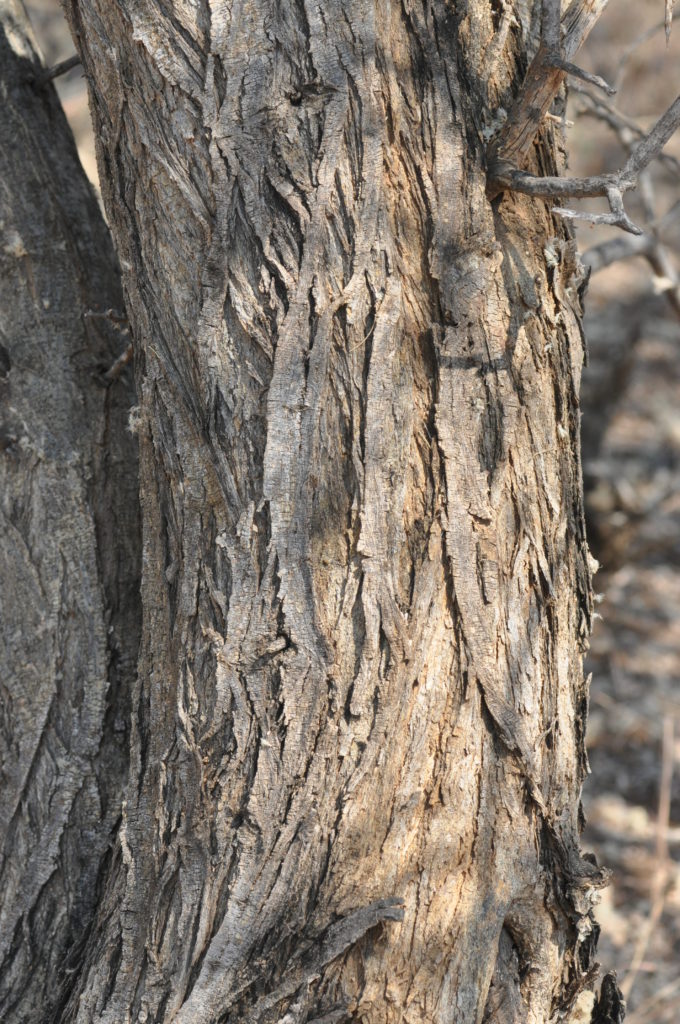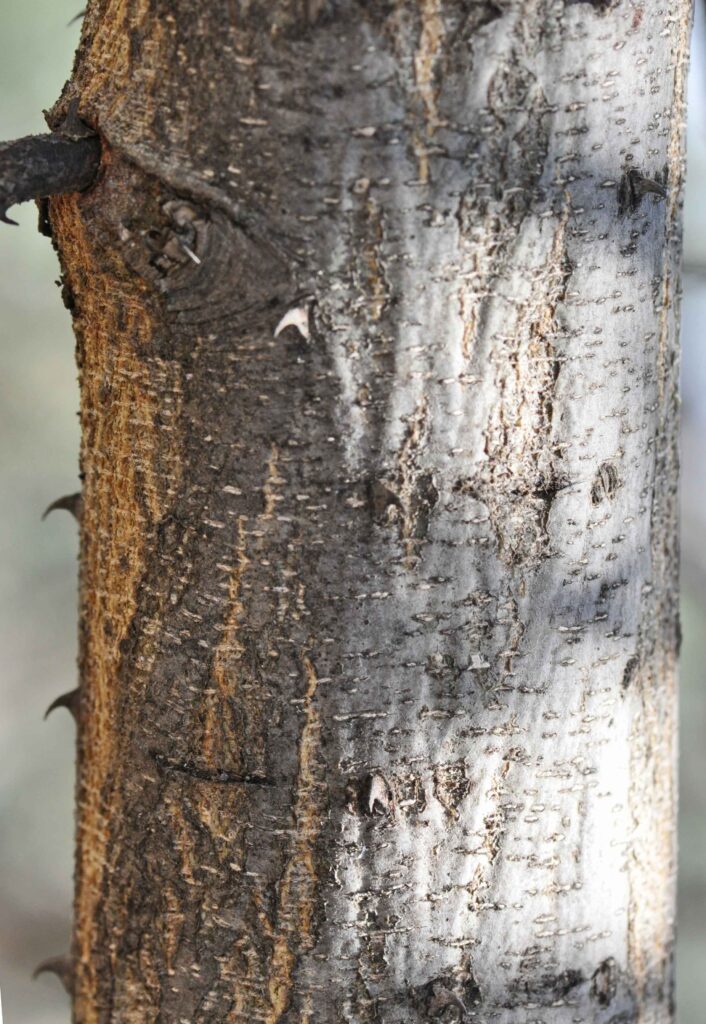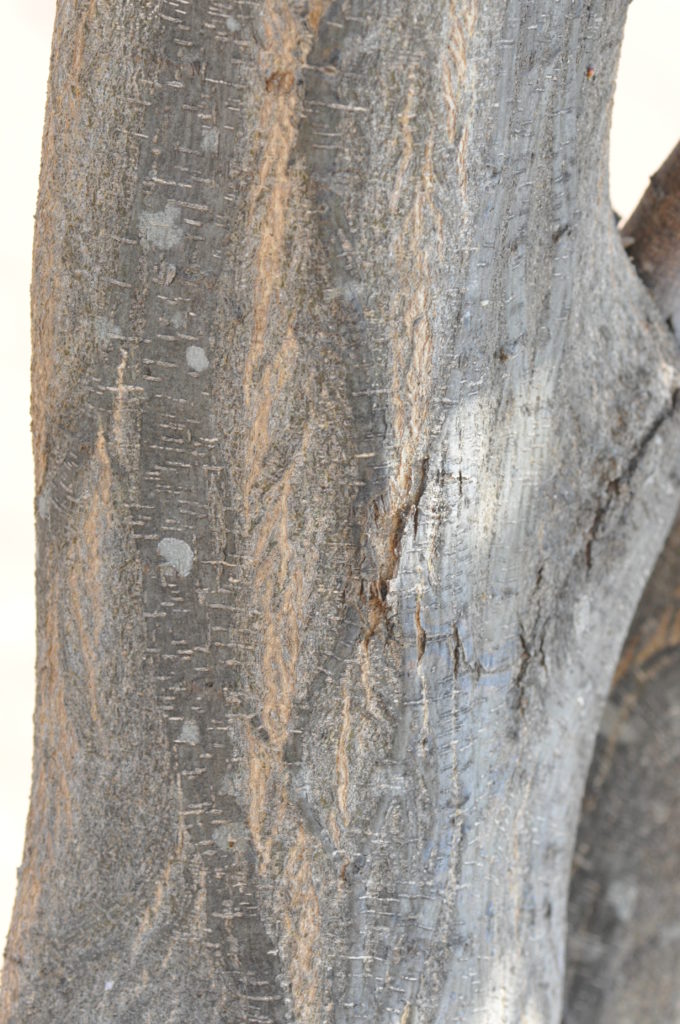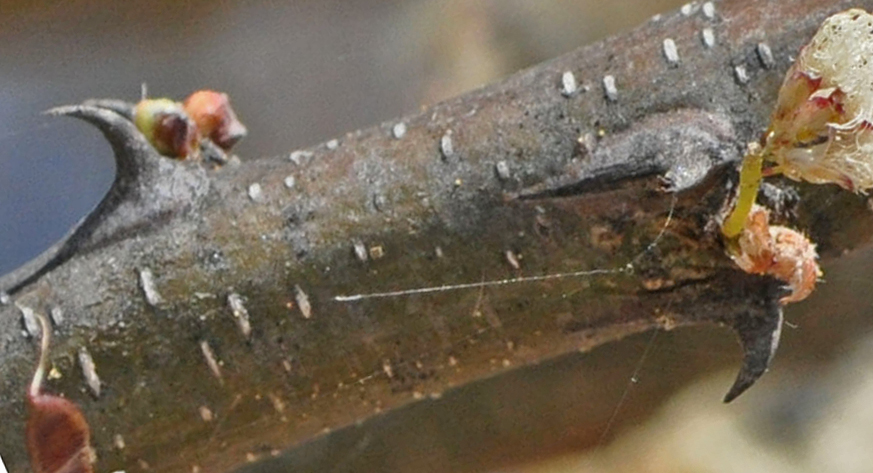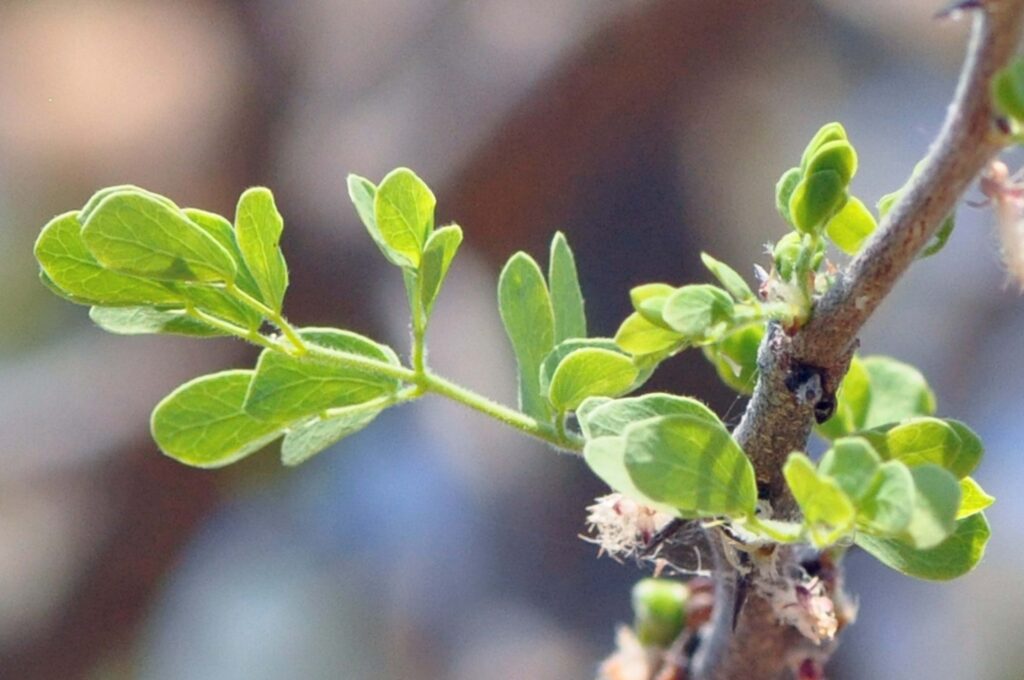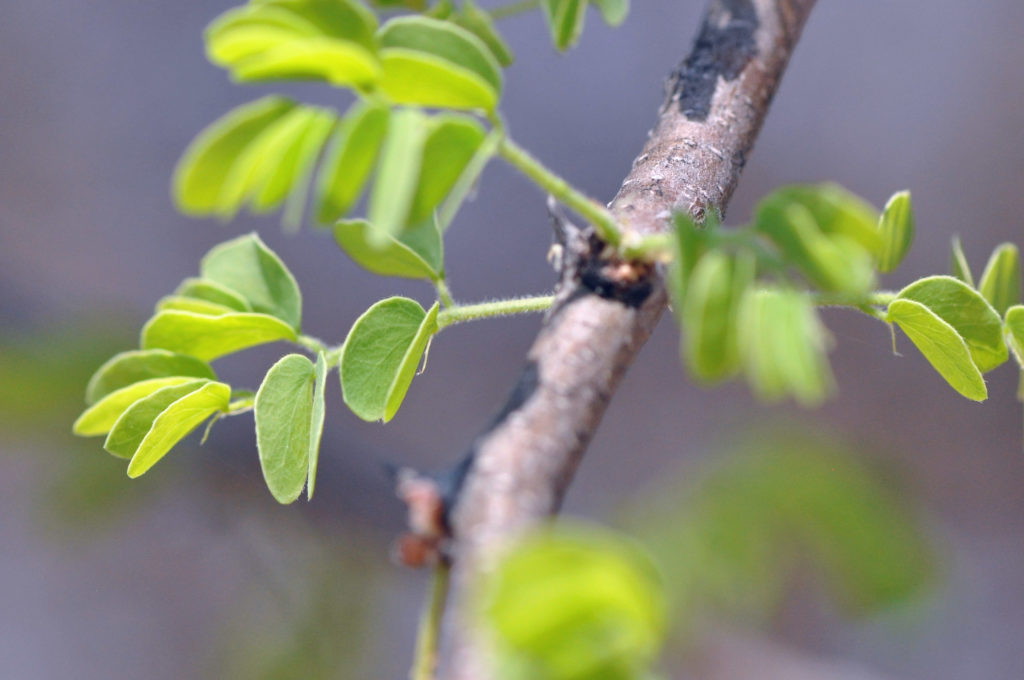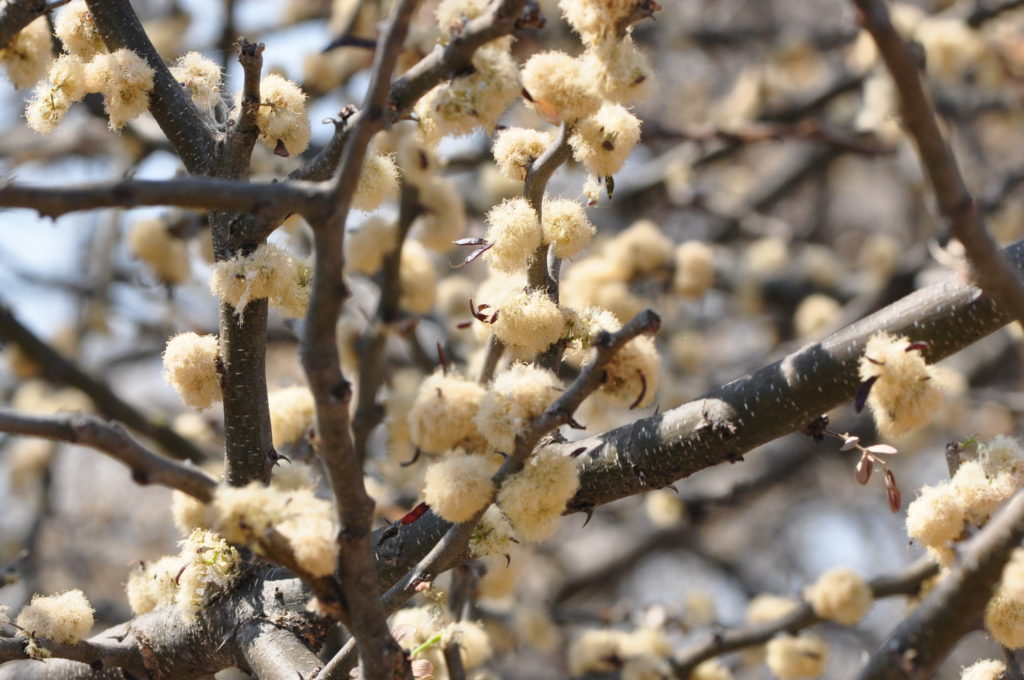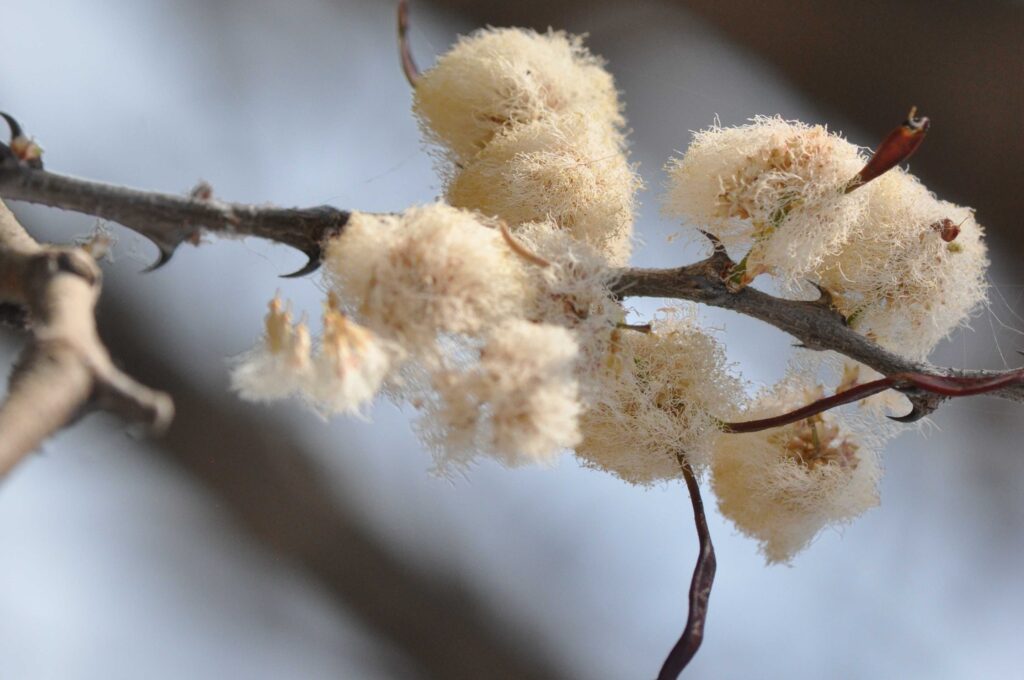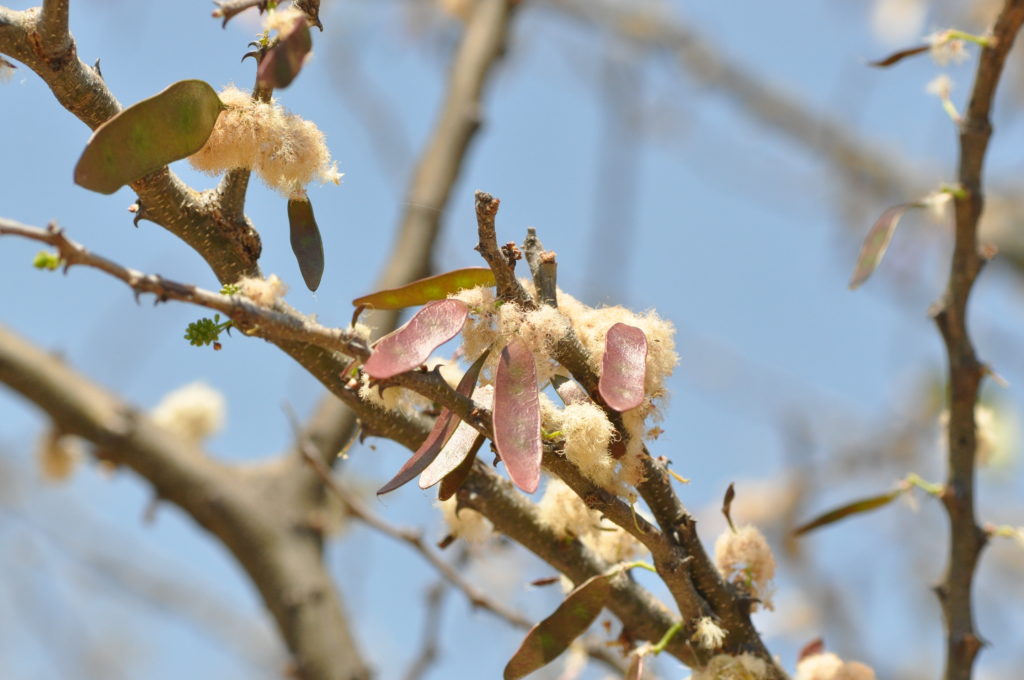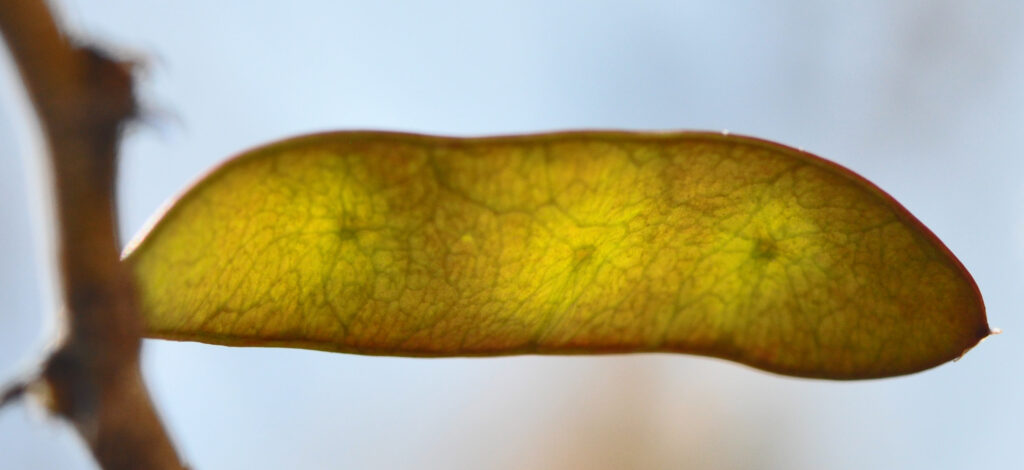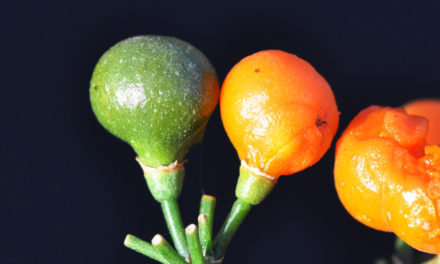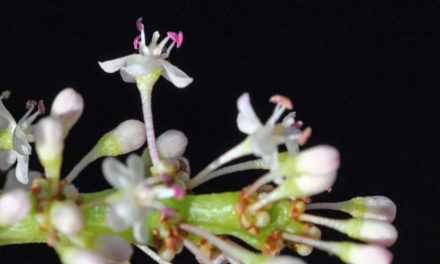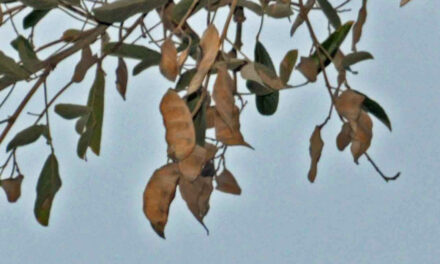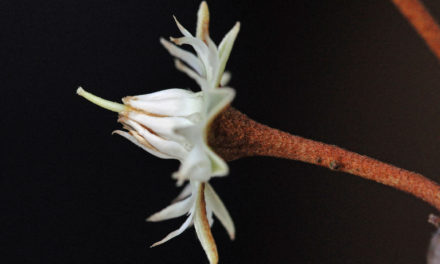General Info – summary
This deciduous Tree may be single stemmed and may reach 9m high or become a multi-stemmed shrub. It has many short, curved, vicious, paired spines. Small bipinnate Leaves have largish leaflets & non-spinescent stipules. Flowers develop in very short spherical spikes with whitish colour generated be exserted male filaments. Female has a superior ovary + filiform style. Fruit – a small papery, dehiscent pod + 2 to 3 seeds.
Description
Senegalia mellifera subsp. detinens
Previous Names: Acacia mellifera, Acacia detinens, Acacia tenax.
SA Tree No. 176.
Common names: (Afr) Beiraboom, Beira Boom, Beira-boom, Blouhaak, Blouhaakdoring, Blou-haakdoring, Blouhaakdoringboom, Bruinhaakdoring, Bruin-haakdoring, Gnoibos, Haakdoring, Hakiesdoring, Heiraboom, Noebos, Swarthaak, Swarthaak-akasia, Swarthaakdoring, Wag-‘n-bietjie, Wag-‘n-bietjie-doring, Weerhaakdoring, Wynruithaakdoring, Wynruit-wag-‘n-bietjie. (Eng) Beira, Black Thorn, Black-thorn, Hook Thorn, Noebush. (IsiNdebele) Umkaya. (Northern Sotho) Mongangatau. (Setswana) Monga, Mongana, Monganakôtswana, Monyaka-tau. (Tshivenda) Munembedzi.
Family: Fabaceae, or Leguminosae (Pea, bean or legume family). After the Orchidaceae and the Asteraceae, the Fabaceae is the third largest Angiosperm (flowering plants) family with 700+ genera and close to 20 000 species. Local Tree genera on this website include Acacia (Vauchellia, Senegalia), Albizia, Bauhinia, Bolusanthus, Burkea, Calpurnia, Colophospermum, Cordyla, Cyclopia, Dichrostachys, Erythrina, Erythrophleum, Faidherbia, Indigofera, Mundulea, Peltophorum, Philenoptera, Piliostigma, Schotia and Xanthocercis. The Fabaceae are recognisable by their fruit and by their pinnately compound Leaves. Leaves may also be simple – even bilobed and usually have stipules – some of which may be spinescent. Leaflets are usually entire. Flowers are bisexual and bracteate. Regular flowers usually have 4-5 sepals and the same number of petals. Irregular flowers have 4-5 sepals and 5 or less petals. Stamens have anthers that have 2 pollen sacs and there are usually at least twice the number of stamens as petals – often 10. The superior Ovary has 1 locule containing 1 or more ovules. The Stigma and Style are simple. The single carpel develops into the Fruit, which is usually a pod. The mature pods may dehisce or break into segments. Seeds vary.
Name derivation. Species of the genus Vachellia and Senegalia were considered members of the genus Acacia until 2005. New Names. The genus Vachellia was named after George H. Vachell (1789 – 1839), chaplain and plant collector in China. Here the inflorescence is capitate (head like) and spinescent stipules are present. Plants in the genus Senegalia – (from Senegal) usually do not have spinescent stipules and the inflorescence is usually a spike. mellifera – sweet honey-bearing (blossoms). subsp. detinens – referring to the many, paired, vicious, curved thorns that holds one fast.
Conservation: National Status: L C. (Least Concern). Assessment: 2005 (W. Foden and L. Potter).
Tree
This single stemmed Tree may reach 8m high. It can also be a multi-stemmed obconical (resembles an inverted cone (intro photo) shrub. The Crown may be approximately spherical (photo 875). The light grey to dark grey and even blackish Bark is initially smoothish (photo 876) and may develop longitudinal fissures (photo 889). Branches tend to develop close to the ground (intro photo). Young branches are olive brown or reddish to greyish brown and have clearly visible, white Lenticels (a usually raised corky oval or elongated area on the plant that allows the uncontrolled interchange of gases with the environment – photos 884 & 877). In addition, young branches have claw-like paired blackish thorns below each node (photo 877). They are up to 22 x 16mm, appear just below each node and curve downwards towards the trunk. These thorns are 2,5-6mm long and are very numerous – more so than in other Senegalia or Vachellia species (photo 877) and are often almost parallel to each other. The Trunk remains greyish brown or becomes purplish black and longitudinally fissured. Single curved spines may occur on the trunk and on old branches (photo 884).
- 875. 2017/09/14. Waterberg. Photo: David Becking.
- 889 2017.09.15 Waterberg. Photo: David Becking.
- 884 2017.09.14 Waterberg. Photo: David Becking.
- 876. 2017/09/14. Waterberg. Photo: David Becking.
- 877. 2017/09/14. Waterberg. Photo: David Becking.
Leaves
Young Leaves are bright green but become dull greyish-green with time. Leaves are bipinnate (compound: twice pinnate). The hairy (photo 887) Rachis (an extension of the petiole of a compound leaf that eventually bears the leaflets) has lateral pinnae “branches” not leaflets and the pinnules “Leaflets” are on these “side branches”). The leaflets are relatively large. A gland is usually present on the upper surface of the short (up to 1,2cm long) hairy Petiole (leaf stalk – photo 888). Glands also occur at the base of upper pinnae pairs. The petiole and rachis may be glabrous or pubescent. The length of the leaf Rachis (main axis) varies between 0,2 and 4cm long. Up to 3 pairs of Pinnae are usually present and this is less than most Senegalia sp. Up to 3 pairs of relatively large, blue-green Leaflets (pinnules) with marginal hairs are present. Each is up to 15 x 12mm. One or more veins arise from the asymmetric leaflet base (photos 887 & 888) which may be folded along the central vein (photo 888). The Stipules (basal appendage of the petiole) are not spinescent (not spiny – photo 888) and soon lost. On this deciduous tree, leaves are usually shed after the first frost.
- 887 2017.09.14 Waterberg. Photo: David Becking.
- 888 2017.09.14 Waterberg. Photo: David Becking.
Flowers
The small, sweet-scented, creamy white to yellowish-white bisexual or occasionally pink Flowers are closely packed. They open before the leaves appear (photo 892). In this photo, the new reddish leaves are beginning to appear. Flower buds may have a purplish or pinkish tinge. They usually occur in very short Spikes (simple indeterminate inflorescence with sessile flowers on a single unbranched axis opening in succession towards the apex), are usually globose (photo 892) but may develop in somewhat elongated spikes in subsp. mellifera. The Pedicels (stalks of single flowers in a cluster) are up to 1,5mm long. The green or pinkish bell-shaped Calyx is very short and the Corolla with its united sepals is up to 3,5mm long. The many Stamens, with their exserted Filaments generate the flower colour (photo 890). The superior Ovary has a filiform (thread or filament like) Style ending in a terminal Stigma. (Sep-Nov).
- 892 2017.09.14 Waterberg. Photo: David Becking.
- 890 2017.09.14 Waterberg. Photo: David Becking.
Fruit
The fast-developing Fruit occurs in dehiscent papery, flat Pods. Young pods are reddish (photo 878) and mature to a greenish-white, straw coloured or pale brown colour. The pods narrow slightly at both ends and are usually up to 9 x 2,5cm. The 2 to 3 Seeds are up to 10 x 8mm and fallen pods may still have attached seeds. In the photo 885 of a translucent young pod, 3 developing seeds are visible. (Jan-Apr).
- 878 2017.09.14 Waterberg. Photo: David Becking.
- 885 2017.09.14 Waterberg. Photo: David Becking.
Distribution & Ecology
These trees are Located in the Northern Cape (mainly north-west), Western Free State, Gauteng, North West, Limpopo, Mpumalanga and northwards to include eastern and southern Botswana, north-west and south west Mozambique, Namibia (including the Caprivi Strip), Tanzania, Sudan and Egypt. They survive in the semi-desert and are common in dry bushveld woodland and semi-desert areas – including the usually red Kalahari sands with tiny windblown particles. These plants also grow in mixed deciduous woodlands and in brackish flat ground. The tree can spread by coppice growth (cutting or burning stems causes regrowth from the stump or roots) and from seeds. These trees can spread very rapidly and form impenetrable tangled, spiny growth. This tree is valuable for both shade and fodder. The leaves and stems have a high percentage of protein. The Pods are very nutritious and sought after by both game like kudu, black rhino, kudu and livestock. Elephants, Eland, Impala, Kudu, Steenbok and Giraffe, consume the nutritious Leaves. Nectar attracts Bats that aid in pollination, and Bush babies (small primates with saucer-shaped eyes that spend most of their lives in trees). The deep Taproot enables the tree to survive further away from streams and rivers compared to some of its competitors. Subsp. detinens is the most widespread of the subspecies.
Ethnobotany
This drought resistance tree provides good shade for stock but may form impenetrable thickets – especially in overgrazed areas. The heartwood is dark brown to greenish-black and makes good furniture and, when oiled, turns almost black. It is termite resistant and is used for fence posts and hut construction. The sapwood is thick and whitish. Extensive use is made of Wood for axe handles as well as fuel and charcoal manufacture. Twigs are chewed and used to clean teeth. Although small, the many Spines were described as rapacious by an entangled person. They are wicked and an unwary traveller can be caught up in them. The tree is considered valuable for its shade and fodder. Goats consume Leaves. The leaves contains a small amount of DMT (N-dimethyltryptamine) – a hallucinogenic drug. Mental side effects may linger for many days or weeks after ingestion of the drug. The Gum is edible or can be mixed with clay to make floors. Soaking seeds in hot water in the morning and planting them the following day can enhance germination. Growth is about 0,5m per year. Best growth occurs in deep sandy soil in frost-restricted areas.
References
Burrows, J.E., Burrows, S.M., Lotter, M.C. & Schmidt, E. 2018. Trees and Shrubs Mozambique. Publishing Print Matters (Pty) Ltd. Noordhoek, Cape Town.
Coates Palgrave, M. 2002. Keith Coates Palgrave Trees of Southern Africa, edn 3. Struik, Cape Town.
Foden, W. & Potter, L. 2005. Senegalia mellifera (Vahl) Seigler & Ebinger subsp. detinens (Burch.) Kyal. & Boatwr. National Assessment: Red List of South African Plants version 2020.1. Accessed on 2023/12/22.
Lawrence, G. H. M, 1951. Taxonomy of Vascular Plants. The Macmillan Company, New York. Tenth Printing 1965.
Palmer, E. & Pitman, N. 1972. Trees of southern Africa. Balkema, Amsterdam, Cape Town.
Ross, J. H. A conspectus of the African Acacia Species. 1979. Botanical Research Institute.
Schmidt, S. Lotter, M. & McCleland, W. 2002. Trees and Shrubs of Mpumalanga and the Kruger National Park. Jacana, Johannesburg.
van Wyk, B. & van Wyk, P. 1997 Field guide to Trees of Southern Africa. Struik, Cape Town.
http://pza.sanbi.org/senegalia-mellifera-subsp-detinens
http://iscantree.co.za/senegalia-mellifera-subsp-detinens-swarthaak-black-thorn/
https://en.wikipedia.org/wiki/Senegalia_mellifera
https://www.revolvy.com/topic/Senegalia%20mellifera
http://www.zimbabweflora.co.zw/speciesdata/species.php?species_id=126050
https://en.wikipedia.org/wiki/List_of_psychoactive_plants
https://www.medicalnewstoday.com/articles/306889.php#risks

